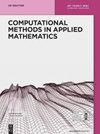压力泊松方程的超弱有限元法和梯度方程的最小二乘法的最优压力恢复
IF 1.2
4区 数学
Q3 MATHEMATICS, APPLIED
引用次数: 0
摘要
从给定的流速重建压力是一项在各种应用中出现的任务,标准方法使用Navier-Stokes方程来推导压力p的泊松问题。然而,这种方法人为地增加了对解和数据的规则性要求。在这种情况下,我们提出并分析了两种替代技术来确定p∈l2¹(Ω) {p\ In L^{2}(\Omega)}。第一个是一个超弱变分公式,应用分部积分法将所有导数平移到测试函数。给出了合适的有限元离散化方法,并证明了Galerkin-Petrov方法的最佳收敛性。第二种方法是对原始梯度方程采用最小二乘法,将其重新表述并求解为人工Stokes系统。为了简化将给定的速度并入右边,我们在推导中假定速度场是螺线形的。然而,这个假设不是限制性的,因为我们可以使用非散度近似,甚至是可压缩速度。数值实验证实了两种方法的最优先验误差估计。本文章由计算机程序翻译,如有差异,请以英文原文为准。
Optimal Pressure Recovery Using an Ultra-Weak Finite Element Method for the Pressure Poisson Equation and a Least-Squares Approach for the Gradient Equation
Reconstructing the pressure from given flow velocities is a task arising in various applications, and the standard approach uses the Navier–Stokes equations to derive a Poisson problem for the pressure p . That method, however, artificially increases the regularity requirements on both solution and data. In this context, we propose and analyze two alternative techniques to determine p ∈ L 2 ( Ω ) {p\in L^{2}(\Omega)} . The first is an ultra-weak variational formulation applying integration by parts to shift all derivatives to the test functions. We present conforming finite element discretizations and prove optimal convergence of the resulting Galerkin–Petrov method. The second approach is a least-squares method for the original gradient equation, reformulated and solved as an artificial Stokes system. To simplify the incorporation of the given velocity within the right-hand side, we assume in the derivations that the velocity field is solenoidal. Yet this assumption is not restrictive, as we can use non-divergence-free approximations and even compressible velocities. Numerical experiments confirm the optimal a priori error estimates for both methods considered.
求助全文
通过发布文献求助,成功后即可免费获取论文全文。
去求助
来源期刊

Computational Methods in Applied Mathematics
MATHEMATICS, APPLIED-
CiteScore
2.40
自引率
7.70%
发文量
54
期刊介绍:
The highly selective international mathematical journal Computational Methods in Applied Mathematics (CMAM) considers original mathematical contributions to computational methods and numerical analysis with applications mainly related to PDEs.
CMAM seeks to be interdisciplinary while retaining the common thread of numerical analysis, it is intended to be readily readable and meant for a wide circle of researchers in applied mathematics.
The journal is published by De Gruyter on behalf of the Institute of Mathematics of the National Academy of Science of Belarus.
 求助内容:
求助内容: 应助结果提醒方式:
应助结果提醒方式:


